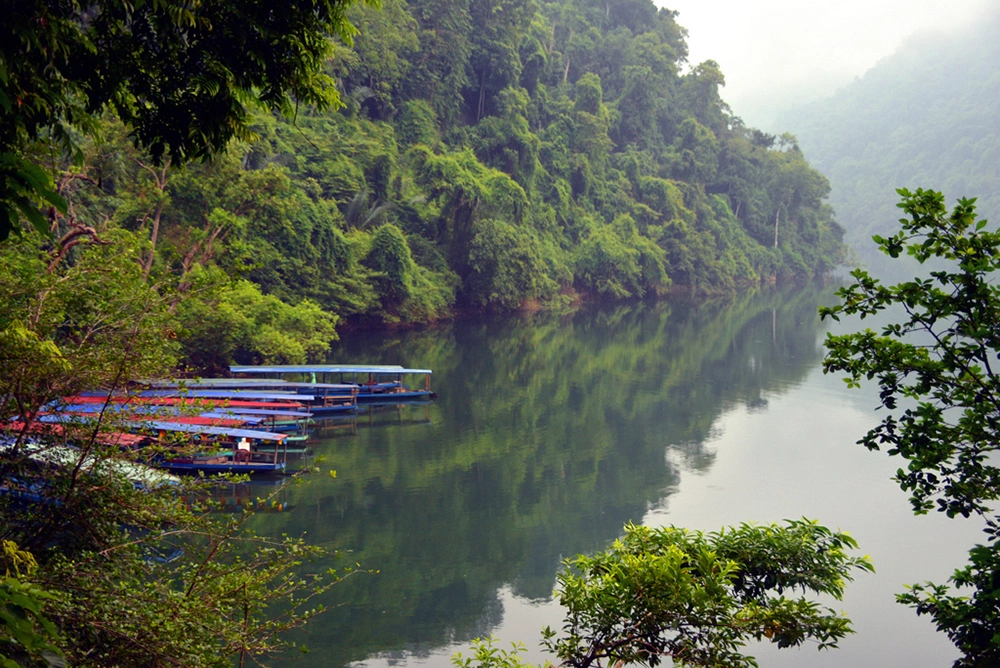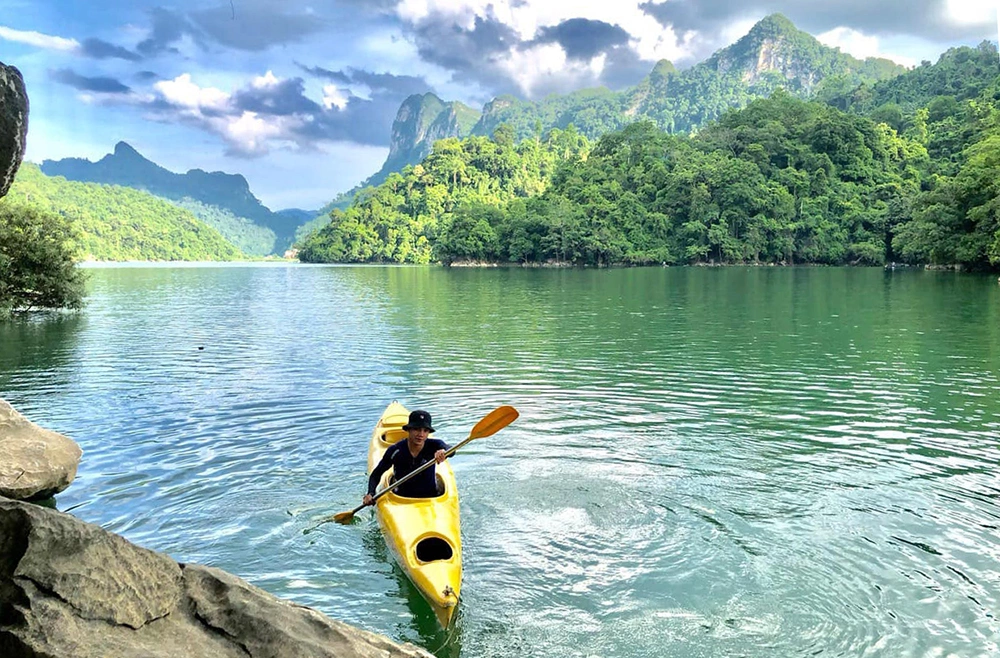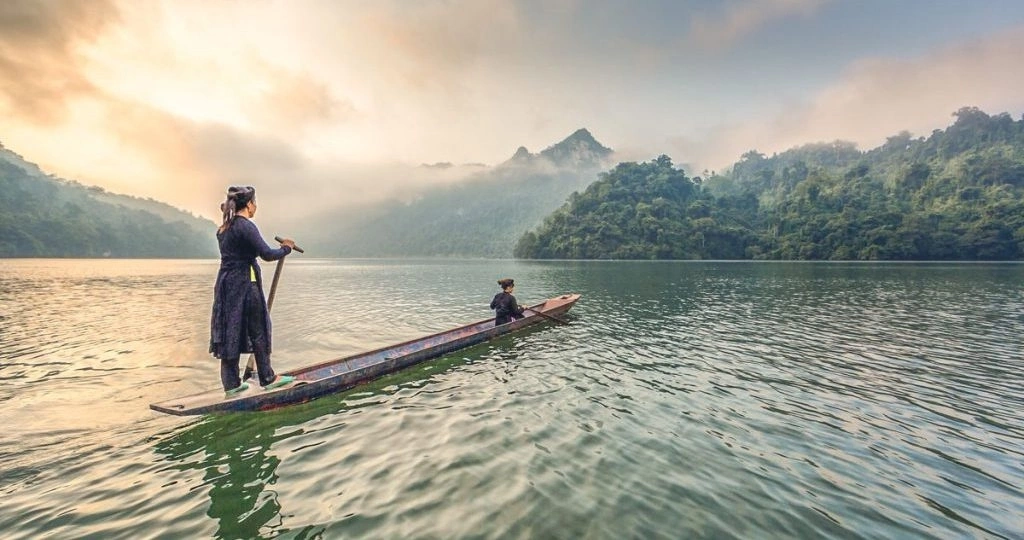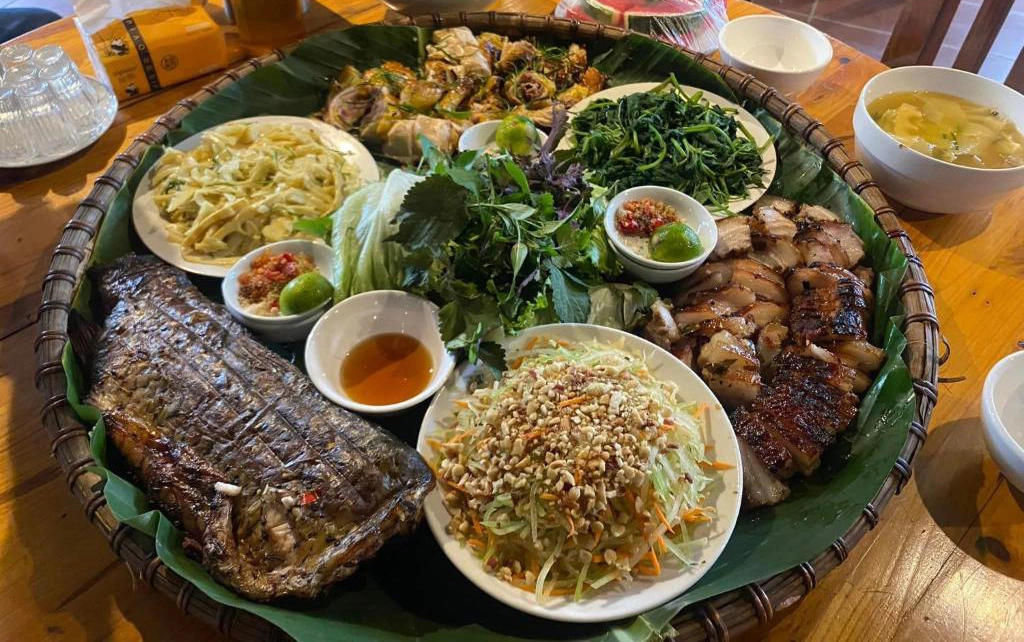
Ba Be, nestled in Ba Be National Park, is one of Vietnam’s largest natural freshwater lakes, known for its status as a prominent ecotourism destination.
The lake is 70 kilometers northwest of Bac Kan City of the eponymous province, within the Nam Mau Commune of Ba Be District, and is about 230 kilometers from Hanoi. It takes its name (literally "Three Lakes") from the series of interconnected lakes that comprise it - Pe Leng, Pe Lu and Pe Lam. Ba Be sits at an elevation of 145 meters above sea level. The lake stretches over 8 kilometers in length and spans up to 3 kilometers at its widest point.
With a water surface area encompassing approximately 500 hectares, an average depth of 20 meters, and its deepest point plunging to 35 meters, Ba Be Lake is enclosed by limestone mountains and a network of subterranean streams and caverns.
The lake is filled with various freshwater fish, some of which are rare and listed in Vietnam's red book of endangered species, like bangana lemassoni or bagarius bagarius.
Ba Be was chosen as one of 20 freshwater lakes in need of protection by the World Lake Conference in the United States in 1995. In 1996, it became a national historical and cultural site. Further enhancing its global importance, in 2011, Ba Be was designated a Ramsar site, confirming its status as a globally significant wetland conservation area.

Visitors can enjoy a boat ride on Ba Be Lake. Photo courtesy of Tran Xuan Homestay
Ba Be Lake attracts tourists all year round, with each season offering its unique charm. The rainy season spans from April to October, while the dry season from November to February with the possibility of frost.
The most favorable time to explore Ba Be Lake is from February to April, when the climate is comfortably cool, with temperatures ranging from 25 to 30 degrees Celsius. During the first lunar month, there are numerous festivals demonstrating the cultures of the local ethnic groups.
Exploring Ba Be Lake
Travelers can opt to rent various watercraft, such as canoes, kayaks, stand-up paddleboards, or traditional dugout boats, typically departing from either Ba Be Lake or Nang River.

Boats dock on Ba Be Lake, where the water mirrors the lush forest and the sky. Photo courtesy of CAT
- Motorboat: These boats can carry 12 Vietnamese guests or 10 foreign guests, and rental prices vary from VND300,000 to VND1 million ($12 to $41), depending on the duration (2 to 8 hours) and route.

Kayaking and stand-up paddleboarding have gained popularity among tourists, offering them the opportunity to fully immerse themselves in nature.
- Kayaking and stand-up paddleboarding: These newer services have emerged in the past 2-3 years, with rental prices ranging from VND1.2 million to VND1.5 million ($49 to $62) for a group of three boats for a day. Each group of three boats can accommodate up to six people.
In addition to on-site rental services, visitors can choose guided tours from Hanoi that combine stand-up paddleboarding, kayaking, and trekking in the national forest, allowing one to explore this northern region. These package tours are priced between VND2 million to VND3 million per person and usually take place during weekends.

Dugout boats provide a unique opportunity to explore Ba Be Lake and envelop oneself in a tranquil environment. Photo courtesy of Luxury Travel
- Dugout boat: This traditional mode of transport, used by the Tay people, offers a cultural experience. Dugout boats are handcrafted from sizable trees, typically measuring around 50 centimeters in width, and ranging from 5 to 10 meters in length. These boats are maneuvered using a single oar by the boat driver. They typically carry 2 to 3 people.
Notable destinations in the Ba Be Lake area include:
Pac Ngoi Village

Pac Ngoi, nestled amidst the serene natural surroundings, offers a tranquil glimpse of village life. Photo by VnExpress/Binh Lam
Pac Ngoi Village, or the Pac Ngoi Cultural Tourist Area in Nam Mau Commune, is home to the Tay ethnic group, nestled near the banks of Leng River and Ba Be Lake. Approximately 40 people reside in this village, which serves as the primary hub for accommodations in the region.
The village features ancient stilt houses with distinctive yin and yang tiled roofs, reflecting Tay architectural traditions. The villagers mainly engage in farming, livestock raising, and fishing in Ba Be Lake.
Visitors to this locale can savor local delicacies such as bamboo-tube rice, grilled fish with meat marinated in powdered grilled corn, and five-color sticky rice. Additionally, travelers can partake in various activities, including fishing, canoeing, and witnessing traditional Tay girls’ singing performances.
Hua Ma Cave
Situated within Ba Be National Park, Hua Ma Cave is accessible via a 300-meter journey from the base of Co Don Mountain, complete with stairs for ease of movement. The cave entrance is 3 meters wide and 5 meters high, leading to a spacious interior spanning about 1 hectare, with heights reaching 40-50 meters, adorned with numerous stalactites and walls.
Legend has it that this was the domain of a malevolent spirit. A general patrolling the area heard the cries of unjust souls, prompting him to organize a grand ceremony, including horse sacrifice. After the ceremony, the crises ceased, and over time, stalactites have transformed the cave into a sacred site.
Dau Dang Waterfall
Found on the Nang River, between Bac Kan and Tuyen Quang provinces, Dau Dang Waterfall formed when the Nang River flowed through the Lung Nham limestone mountain, creating Puong Cave. Flowing toward Hua Tang Village, the river is obstructed by a multitude of large rocks, giving rise to the waterfall.
The waterfall extends for over 1,000 meters, featuring three tiers with gaps of 3 to 4 meters between each. This locale is home to the rare bagarius fish species, some of which can weigh several tens of kilograms.
Fairy Pond
Fairy Pond is a petite lake spanning approximately 3 hectares, with underground water connections to Ba Be Lake and nearby caves. Despite being roughly 100 meters from the lake, Fairy Pond remains perpetually filled with water. The pond is encircled by moss-covered steps, limestone mountains, and ancient forests, creating a tranquil, enigmatic atmosphere that piques visitors' curiosity.

Ba Be entices diners with its diverse range of specialties, captivating both the palate and the eye with their flavors and presentations. Photo courtesy of Booking
Grilled fish
Grilled fish is a cherished local dish. Freshly caught fish, prepared with spices, is grilled over charcoal. The best way to enjoy it is hot, alongside other local dishes.

Chinese sausage
The Chinese sausage at Ba Be Lake is crafted using pork sourced from the region. Notably, it's marinated with a local ginger variety, exclusive to limestone mountains, prized for its spiciness and fragrant aroma, which infuses a unique flavor into the sausage.
After preparation, the sausages are either smoked or stored in kitchens for long-term preservation. This dish is a favorite among many and pairs well with local wine.
Dried meat
Like dried buffalo meat in the kitchens of the Northwestern highlands, the Tay ethnic people employ this method to preserve meat for year-round consumption. Hanging pork in the kitchen not only extends its shelf life but also enhances its flavor. Today, locals still prepare meat dishes in the kitchen for special occasions when entertaining esteemed guests or celebrating Lunar New Year.
Within Ba Be Lake, visitors will find a variety of lodging choices. Prices for a room accommodating two people range from VND150,000 to VND1.2 million ($6 to $49). If you prefer community houses, they typically cost between VND70,000 to VND100,000 per person.

Many homestays operated by the Tay ethnic group are clustered along the lakeside. Photo by VnExpress/Dang Hai
Accommodations located close to Ba Be Lake, offering balconies or rooms with lake views, are mainly local homestays, often including communal living spaces. These options normally provide basic amenities. Visitors seeking more fully equipped accommodations may need to look a couple kilometers away from the lakeside, in the area near the national park entrance.
For those seeking recommendations, Tripadvisor suggests several places, including Thai Binh Hotel, Saigon Ba Be Hotel, Ba Be National Park Hotel, and homestays like Huyen Hao, Tran Xuan, Hoang Nguyen, and Minh Quang.
For a unique experience, camping along the lake has become increasingly popular. Some recommended locations include the alluvial land at the end of the Leng River in Pac Ngoi Village, the Hoi Xuan area, Lac Nga Garden, and Puong Cave. Prices for camping vary from VND1 million to VND2 million per person, depending on the level of service provided.
To reach Bac Kan, one can take either of two routes from Hanoi: the first involves following the old National Highway 3, which takes about 3 hours, while the second option entails taking the Hanoi - Thai Nguyen Expressway and then continuing on National Highway 3, reducing travel time to approximately 2 hours, but is only feasible for car travel.
Once in Bac Kan City, travelers can embark on the journey to Ba Be Lake through two routes: either by taking provincial road 256, covering a distance of around 60 kilometers, or via provincial road 257 leading to Don Market, followed by a continuation to Ba Be, which extends the journey to around 70 kilometers.
Travelers can also opt for passenger buses departing from My Dinh bus station in Hanoi. There are several bus companies operating routes to Bac Kan or Cao Bang City, passing through popular tourist destinations, including Ba Be Lake.
For visitors traveling from Ho Chi Minh City and southern provinces, the most practical approach is to fly to Hanoi and then follow the instructions above.
The mornings and evenings at Ba Be Lake tend to be chilly, even during summer, so it's advisable to bring a jacket. Additionally, insect repellent is necessary due to the presence of mosquitoes and other insects.
Given the limited number of food and grocery stores in the village, visitors should plan ahead by bringing snacks and beverages. It's recommended to pre-order meals.
For those interested in staying in Pac Ngoi Village, motorbike taxis can be hailed at the national park gate, or arrangements can be made through the homestay for transportation services.
Story by Tam Anh